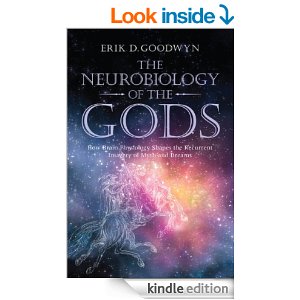 What does neurobiology, symbolic imagery and the writings of Jung all have in common? They are all featured and linked together in the book The Neurobiology of the Gods (2012) by Erik Goodwyn. The text takes CG Jung’s writing and applies the concepts to modern neuroscience. The result is an explanation for why human’s create symbolic imagery and could potentially be helpful for anyone trying to understand that kind of human experience, like analytical psychologists, traumatologists, or even evolutionary psychologists. Goodwyn says of the book that the primary focus “is in symbolic imagery- how the brain constructs it, interacts with it, and imbues it with numinous significance (in the case of gods).” In the work, Goodwyn also goes back and looks at the origins of when humans began using symbolic imagery in the evolutionary process.
What does neurobiology, symbolic imagery and the writings of Jung all have in common? They are all featured and linked together in the book The Neurobiology of the Gods (2012) by Erik Goodwyn. The text takes CG Jung’s writing and applies the concepts to modern neuroscience. The result is an explanation for why human’s create symbolic imagery and could potentially be helpful for anyone trying to understand that kind of human experience, like analytical psychologists, traumatologists, or even evolutionary psychologists. Goodwyn says of the book that the primary focus “is in symbolic imagery- how the brain constructs it, interacts with it, and imbues it with numinous significance (in the case of gods).” In the work, Goodwyn also goes back and looks at the origins of when humans began using symbolic imagery in the evolutionary process.
Goodwyn looks at the neurobiological aspects of symbolic imagery using the framework of Jung’s ideas like collective unconscious, archetypes and dreams, as well as with the work of neuroscientists like Jaak Panksepp, Antonio Damasio, and Joseph Le Doux. Rather than discounting the work of either philosophy or modern science he uses both to compliment and support each other. Goodwyn concludes that symbolic imagery is how humans decide to make sense of experiences or concepts that they cannot understand. He states that symbolic imagery, meaning any “internally derived sensory impression” and images are really just ways that we guide ourselves mentally so that we have meaningful lives that we understand. Goodwyn writes, “the dream scientists Hall and Nordby, in analyzing some 50,000 dreams from subjects all over the world, found repetitive universal themes that included conspecific aggression and status striving, predatory animals, flying, falling, being pursued, landscapes, sex, misfortune, marriage and children, being socially scrutinized, traveling, swimming, watching fires and being confined underground. These elements they called ‘universal constants of the human psyche’…this data has held up remarkably well over time…Furthermore, when viewed cross-culturally, dreams ‘are more similar than they are different around the world’ … suggesting a common source of stock concerns that are resistant to cultural variation.” So our dreams are similar throughout culture and symbolic imagery remains an entirely human phenomenon. We need images and metaphors to understand what we go through emotionally and to help explain anything that does not make sense scientifically.